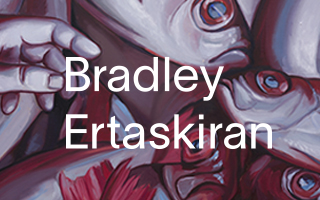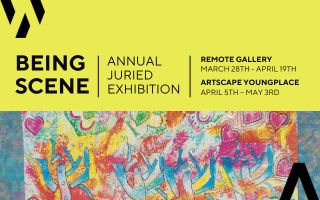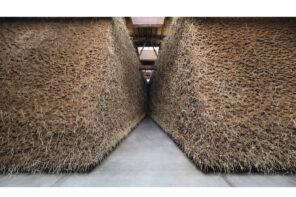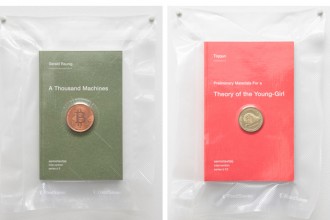In order to enter the Union Station’s Great Hall – a stunning keystone of Toronto’s historic architecture, with soaring coffered ceilings and heritage marble floors – one must endure a character-testing pursuit of correct signage, and resist the urge to give up before beginning. You’re beleaguered by heaving commuting masses, dripping pipes and cloaked scaffolding, and something like personal trial. This takes an urban aesthete’s particular brand of faith, as getting oneself to the hall is worth the effort. There, environmental pleasures absorb and transcend the remnants of a city’s churning bowels, and our journey is shed through the transformative effects of a clerestory of light, the hall’s aerial volume, and its central clock that signals our mortal passing; we are made anew.
My disappointment, then, in the eagerly-anticipated international art event, Villa Toronto, held at the Great Hall, might be informed by my deep attraction to its building’s clean lines and the redemptive qualities of space and light. These have been complicated and obscured by the fair-like exhibition’s temporary walls and battery of installation works, which are flooded by the transient movement of lingering crowds, performances, and talks.
But I think, in fact, the measure of my disappointment has less to do with the event’s absorption of a spare (and personally cherished) architectural space, and more to do with its unfortunate resemblance to the city’s unfinished venter from which its audience emerges. The walls are stitched together, the wires apparent. The lights (Union Station’s unique sepia glow) are insufficient, and so a smattering of galleries has improvised spotlights, with sandbags and crude clamps for ballast. More wires, then. Dust on all the vitrines, projections askew. Track marks on podiums and finger smudges on plinths.
Granted, some of the space’s visual detritus was surely unavoidable (ATMs, trash bins, yellow fencing); and the traces of an observing public (Union Station sees 200,000 travelers a day) is surely an encouraging sign of its incidental audience leaning in (and on) to the exhibition’s varied wares. But Toronto’s version of Villa (this being a roving exhibition’s fourth edition, after Warsaw, Tokyo, and Reykjavik) bears a shabbiness that is less DIY than distracting; and one that, ultimately, detracts from the work. This inattention to detail (or lack of resources) results in the effort feeling like exactly that, an effort.
Villa’s highlights do manage to shine through the chalky cracks. In addition to a much-hyped and exuberant (if hubristic) performance at the AGO on opening night, Villa mainstay Ragnar Kjartansson exhibits a split-screen video work that quite literally sets the tone for the event. Drunken Voyage, filmed during the 2013 Venice Biennale on a miniaturized Viking boat, issues a song that washes through the hall like so much canal water, filling all the corners and crevasses of its closeted presentations. The boat’s band, a troop of warbling brass players, pauses at the end of their melancholic song (what sounds like a rendition of Radiohead) to empty their instruments of spit, and reposition their horns. The inclusion of this vulnerable and almost comically pedestrian moment at the end of a majestic gesture and moving image, seems fitting to Villa’s profile, here. The veneer is tarnished, the process revealed.
Toronto’s Daniel Faria showcases the fiction-infused and mottled sculptures of Iris Häussler, and anchors them in an interactive screen featuring the newly-constructed online venue for Häussler’s artistic foil, Joseph Wagenbach. Faria does well to light his plinthed forms from above, canopying them in dramatic, shadow-inducing light, and closing-out the sepia tinge. Similarly, Clint Roenisch is effective in re-exhibiting Tony Romano’s poetic sculpture, The Final Crystallization (2014), a 16mm film-loop that wends its way through the branches of a cast aluminum and chromed tree branch in order to project a moving, abstract form.
Tyler Coburn, a New York-based artist and writer, presented an articulate and well-paced talk/performance through one of Villa Toronto’s many collaborators, Kunstverein Toronto. He distinguished himself from a program of less-compelling talks and panels (Reto Pulfer quietly discussing his foraging practices at the Drake Hotel, for instance, was a deeply disappointing off-site event, if only for his inability to compete with the surrounding cacophony of espresso machines and bar buzz). Despite Coburn’s stage presence and composure, however, he couldn’t fully transcend the presence of nettled wires, faulty technology, and installation rubble. As commuters walked through the doors to his left and right, they occasionally slowed their pace, like a forking river that eddies at its cleave, and listened to a line or two of Coburn’s poetic recitation.
These passersby bore a typical expression of intrigued confusion that was emblematic of the most pervading problem with Villa Toronto: the work was too abstract. From the subtleties of Patricia Dauder’s wall impressions to the insider-joke elicited by Michael Portnoy’s portraits of kale, Villa’s exhibition gestures at inclusion in its theme (communication), and position (Union Station), but not its form or content. The question we’re left with – and it’s a good one, I’m happy it’s been provoked – is how do we bring the outside in? Whether we’re inviting international galleries to our heritage sites, or pedestrian traffic to our art, where is the access point, and how do we exhibit more generosity? Villa Toronto is, in effect, an effort that feels like a trial; and in this, it demands of us better resolutions.













